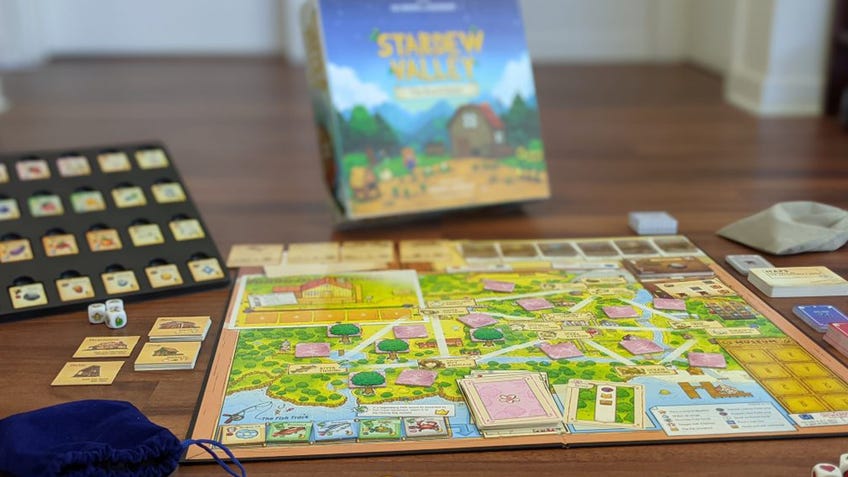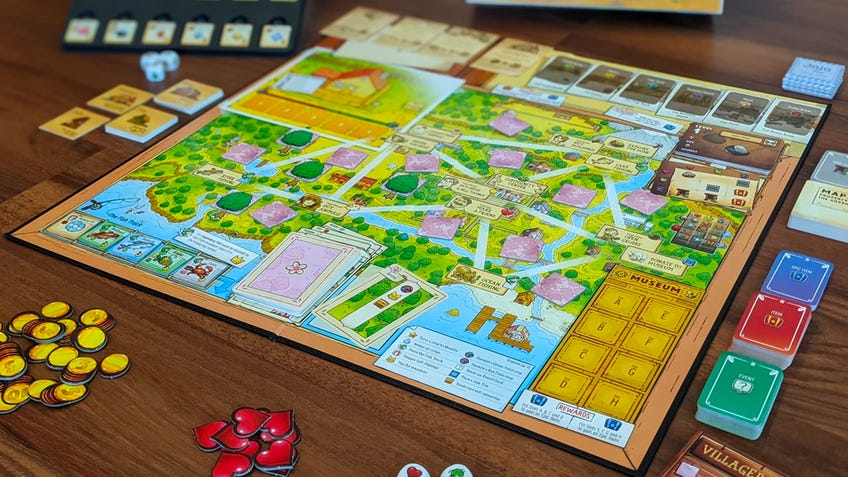Stardew Valley: The Board Game review - from chill, charming farm sim to frustrating, unforgiving tabletop adaptation
Harvest Mourn.
Stardew Valley: The Board Game has the seemingly impossible task of recreating one of the most beloved indie video games of all time into a board game. The result is a lovely, but bloated cooperative game hampered by a more startling degree of frustration than is ever felt playing the video game.
Stardew Valley may be a farming sim, but there are tons of other activities to accomplish. The board game includes them all: making friends with villagers, upgrading tools, plumbing the depths of the monster-filled mine, fishing in multiple locations, chopping down trees and cracking open geodes.
The goal is to complete four of Grandpa's Goals, as well as restoring the community centre by completing a series of six randomised bundles that demand various goods. Goals are randomly drawn at the start of each game and, due to the game's harsh difficulty, dictate exactly how that game should be played. Some goals you'll be doing anyway, like making friends and amassing wealth, while others you can comfortably skip if they don't come up, such as filling out the museum or fishing for legendary fish. If you're unlucky enough to get the mining and fishing goals together, you've probably already lost.
After choosing a profession and a starting tool, each player has two actions they can perform on their turn by moving around the gorgeous map of Pelican Town. The components in Stardew Valley: The Board Game are one of its best features. The large board lovingly recreates the map of the town and surrounding areas you can visit in the video game, such as lake fishing, Pierre's General Store and the museum, while the colourful art for crops, people and other goods translates beautifully to cards and tiles.
The components in Stardew Valley: The Board Game are one of its best features.
At the beginning of each round, the starting player draws from the season deck. The deck is created during setup from a larger collection of cards, further adding to the board game's impressive - and, at times, frustrating - randomised setup. The beginner setup features the same four cards for each season, but after the first game you're encouraged to mix it up with the larger deck (though still limiting it to four cards per season). In one game, we received almost no free villager gifts from the season deck, a normally crucial benefit throughout the game, but we were able to replenish the fish track nearly every round, allowing us to quickly grab the otherwise extremely difficult to catch legendary fish.
In the video game, players have limited stamina and time each day, but are otherwise free to accomplish whatever they wish and play at their own pace. The board game, meanwhile, demands ruthless efficiency for every action. Every player has 32 actions in each game, which is usually not enough to complete all the goals and bundles, as all of them scale to the number of players. The problem is twofold: the constant demand for hearts (friends), and the punishingly random dice rolls of fishing and mining.

Making friends with villagers is entirely optional in the video game, but in the board game it's a critical component. By taking an action, you can draw from the villager deck, hoping they accept whatever resources you've acquired. By giving them a one-time gift, you can earn their friendship and generate one to three hearts. Hearts are needed to reveal the community centre bundles. For three players you’ll need 18 total hearts, meaning you’ll need to invest a significant number of turns. Many actions will be spent trying to make friends, and it's a crapshoot as to which ones you draw, and whether their future gift abilities will be helpful or useless (or whether you trigger them at all).
With very limited turns, it's incredibly frustrating to spend both actions in the mine and come away with absolutely nothing to show for it.
The other frustrating elements are the dice-powered mining and fishing actions. Fishing matches the results of the dice roll with the fish on the track, but you're limited by your location and which fish are available, randomly drawn from a bag. And good luck if the fish requires a crab pot (bug meat). For some reason bug meat, a common trash item in the video game, is incredibly rare in the board game, and those fish can completely lock up the fishing track.
The mine also relies on rolling dice. While I appreciate the complex and lengthy mine transformed into a series of map cards, there are far too many blank spaces, leading to many actions that go nowhere. With very limited turns, it's incredibly frustrating to spend both actions in the mine and come away with absolutely nothing to show for it.
Official and unofficial variants already exist to mitigate some of the challenges, but as it stands Stardew Valley: The Board Game is designed for a niche group: fans of the light-hearted video game who are also hardcore board game strategists.
I'm more than okay with challenging co-op games where victory is a rare treasure, but I've yet to play a game of Stardew Valley: The Board Game in under two hours that wasn't a hardcore endurance run, hoping to snatch victory from the jaws of defeat, which is completely incongruous with the video game we all fell in love with.
Buy Stardew Valley: The Board Game from publisher ConcernedApe.



